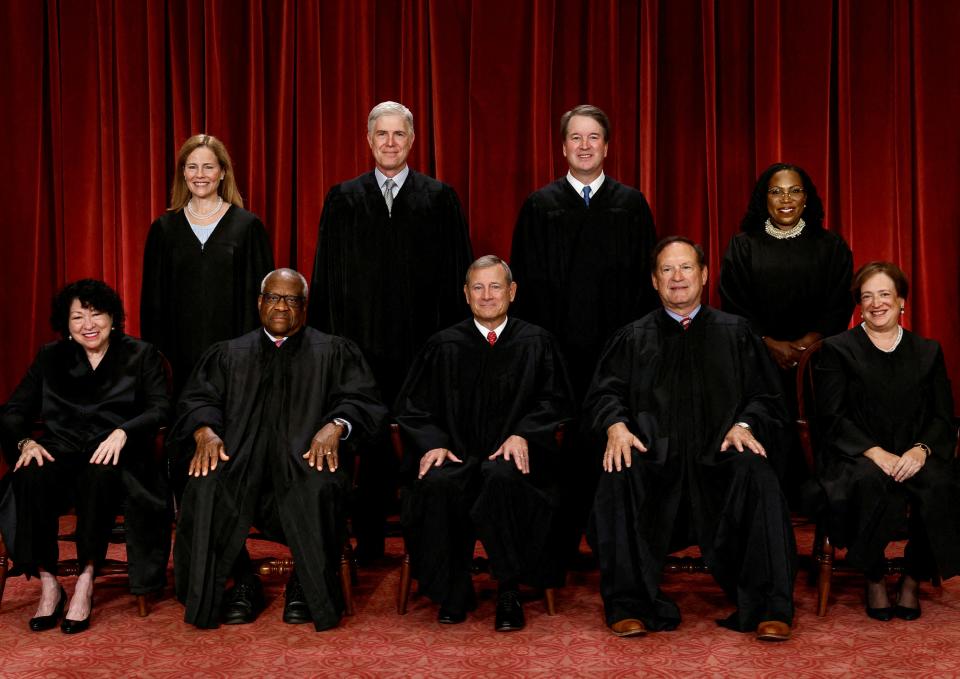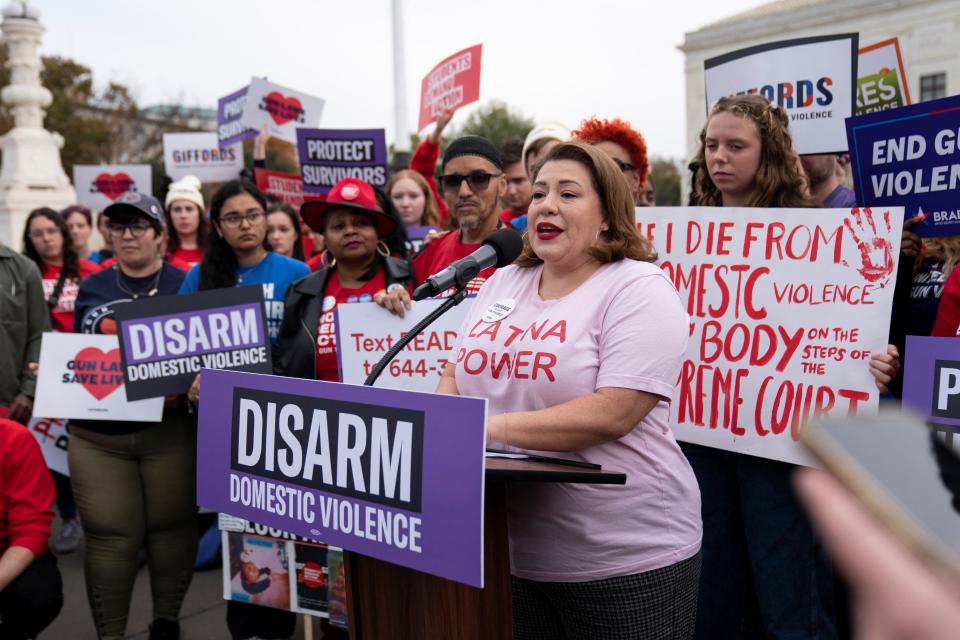Win for Trump, surprise on abortion: Takeaways from historic Supreme Court term
WASHINGTON – It was one for the history books.
The Supreme Court ended its term last week granting broad immunity from criminal prosecution to presidents in an ideologically divided decision with major implications for this fall’s presidential contest between Donald Trump and Joe Biden.
And that wasn’t the high court’s only monumental decision this year.
The conservative justices trash canned a 40-year doctrine that gave deference to federal regulators in legal disputes, a top goal of a long-standing campaign of conservatives to shrink the “administrative state.”
Other decisions either made it generally easier to challenge federal rules or weakened the enforcement ability of specific federal agencies.
Rulings on culture war issues were less consequential. But that’s in large part because the court unexpectedly punted on two potentially major abortion cases, as well as on attempts by conservatives to fight what they saw as censorship of their views on social media.
On the always contentious issue of gun rights, the court created a slightly larger window for firearm restrictions than it appeared to have set in a landmark 2022 decision about the 2nd Amendment. But it still left confusion about how that decision applies to bans on assault-style rifles, to bans on felons owning guns and to other restrictions being challenged in the lower courts.
In keeping, however, with its overall eagerness to block the executive branch from perceived overreaching, the majority struck down a Trump-era ruling that bump stocks meet the legal definition of a machine gun so can be banned.
There were other highlights and greatest hits of the term. Amy Coney Barrett with her emergence as a distinctive voice, Sonia Sotomayor with her impassioned dissents, Samuel Alito with his flag drama, and Clarence Thomas with his staked out positions some deem as extreme were critical Supreme Court personalities.
Here are the top takeaways for the term.
A huge win for Trump ? with deeper implications for an election year, and for the presidency
The justices were largely united in March when they said Colorado couldn’t use an anti-insurrectionist provision of the Constitution to kick Donald Trump off the ballot. The court’s three liberals did accuse the conservative majority of going further than necessary to protect Trump from additional challenges to holding office, even as they agreed he must remain on Colorado’s ballot.
But the court was bitterly divided along ideological lines when it put limits on how prosecutors can try Trump for attempting to overturn his 2020 election loss.
Presidents, the majority said, have absolute immunity for core presidential responsibilities ? and they have a presumption of immunity for other official acts. Prosecutors can still go after actions Trump took in his capacity as a candidate, and they can make a case for why some of his actions as president should not be immune. But the extra hurdles make it basically inevitable Trump won’t face trial before the November election.
In their dissent, the court's liberal justices said the majority gave Trump “all the immunity he asked for and more.”
But Chief Justice John Roberts said the dissenters' "tone of chilling doom" discounts the fact that the majority ruled that only Trump's official discussions with his attorney general are absolutely immune from prosecution, and directed the lower courts to apply the new immunity rule to other aspects of the charges against Trump.
Conservative majority torpedoes regulatory agencies
The majority overturned the landmark 1984 decision Chevron v. Natural Resources Defense Council, achieving a major conservative objective to dramatically shrink the regulatory power of the federal government.
Former White House counsel Don McGahn had been clear about using Trump's Supreme Court nominations to further that goal.
"There is a coherent plan here where actually the judicial selection and the deregulatory effort are really the flip side of the same coin," McGahn told a conservative gathering in 2018.
As a result of the 6-3 decision, courts will no longer have to accept agency expertise when corporations or others challenge regulations to protect the environment, consumers, workers, public safety and more.
“This decision shifts power from agencies to courts, which is troubling to some because agencies are very deliberative, made up of experts, and offer a democratic forum for policymaking," Josh Galperin, a Pace University law school professor and an expert in environmental law. “Sometimes Congress leaves ambiguity in statutes because Congress wants agencies to make policy decisions.”
The conservative majority said it’s the role of courts, not federal agencies, to interpret federal statutes if Congress hasn’t clearly enough told regulators how to do their job.
In a separate decision, the conservative majority also said regulations can be challenged long after they’ve gone into effect. And they said the Securities and Exchange Commission can’t use an in-house enforcement mechanism to protect investors against securities fraud. Instead, any penalties have to be decided through a jury trial, the court said in an opinion that could lead to similar challenges to other federal agencies.

Protecting the environment takes a blow ? again ? from the Supreme Court
For the third year in a row, the Supreme Court curtailed the federal government’s efforts to protect the environment.
In June, a bare majority blocked enforcement of the Environmental Protection Agency’s plan to reduce smog-forming pollution that drifts across state lines while those regulations are being challenged by industries and polluting states as overburdensome.
Last year, the court sharply limited the EPA’s ability to control wetland pollution.
In 2022, the court said Congress hadn’t given the EPA authority to curb carbon emissions from power plants.

Punting on abortion access fights
The court avoided detonating an election-year bomb on abortion access by dismissing two cases without deciding the underlying issues.
The court said the anti-abortion doctors who challenged a widely used abortion drug had not shown they were sufficiently affected by the Food and Drug Administration’s loosening of restrictions on mifepristone. Anti-abortion groups are hoping another challenge being mounted by three states will have more success, or that a new administration could order changes if Republicans win the White House.
In the second case, the justices returned to the lower courts a fight over whether a federal law requires hospitals to provide emergency abortions. While the high court allowed doctors in Idaho to perform for now abortions needed to stabilize a woman’s health as the litigation continues, abortion rights advocates said doctors and their patients around the country needed clarity they didn’t get on what care can be provided in states with strict abortion bans.
Punting on social media
Despite hearing multiple cases this term that had the potential to rewrite how Americans interact online, the impact was minor. In one set of cases, the court said that public officials can sometimes be sued for blocking critics on social media if they use platforms to make official statements.
But because the court dismissed for procedural reasons a case about how far the government can go to pressure social media companies to remove or downgrade posts, the justices did not answer the underlying question. And they sent back to the lower courts for more review challenges to laws passed by Texas and Florida to limit the ability of platforms to moderate content.

Gun rules continue to evolve
After a series of rulings expanding gun rights under the 2nd Amendment in recent years, the court in June softened a 2022 decision that said gun prohibitions must be grounded in history.
Everyone except Thomas ? who authored that 2022 decision ? said a regulation doesn’t have to have a “historical twin” to be constitutional. That allowed the court to uphold a ban intended to keep domestic abusers from having firearms. But it left a lot of questions about the constitutionality of many other gun restrictions under the 2022 test.
And in a gun case that didn’t involve the 2nd Amendment, the court said the federal government went too far in 2018 when declaring a bump stock met the legal definition of a machine gun so could be banned. That case was based on whether the Bureau of Alcohol Tobacco and Firearms had correctly applied the law’s technical definition of a machine gun to a bump stock.
Conservative rift over `originalism'
Some of the cases exposed a rift among the majority about the proper way to use history under “originalism,” the dominant judicial philosophy of the conservative legal movement.
Originalists try to interpret the words of the Constitution as they would have been understood by the framers at the time of the nation’s founding.
But Barrett warned against the pitfalls of relying too narrowly on history and tradition to determine the original meaning.
That can lead to missing the forest for the trees, she wrote in a case about a trademark dispute.

The conflict was most apparent in the Second Amendment dispute about banning guns from domestic abusers.
The court’s three liberals said the majority’s 2022 decision that gun regulations must be grounded in history was creating chaos in the courts.
Justices Neil Gorsuch and Brett Kavanaugh defended using “text, history and tradition” to decide cases.
“History is far less subjective than policy,” Kavanaugh wrote. “And reliance on history is more consistent with the properly neutral judicial role than an approach where judges subtly (or not so subtly) impose their own policy views on the American people.”
But Barrett said that there are “serious problems” with demanding “overly specific analogues.” Those problems include forcing 21st-century regulations to follow late-18th-century policy choices, she wrote.

Liberals: `I dissent'
There are days, Sotomayor said in May, when she’s so upset by the decision in a case that she closes her office door and cries.
“You have to shed the tears, and then you have to wipe them and get up and fight some more,” the most senior of the justices appointed by a Democratic president said during an event at the Radcliffe Institute for Advanced Study at Harvard University.
She fought back on the the majority’s ruling to throw out a ban on bump stocks with a fiery dissent delivered from the bench, a rare move used to emphasis disagreement. That decision, she said, will have deadly consequences.
When the majority said homeless people could be fined or jailed for sleeping in public, Sotomayor called that unconscionable and unconstitutional.
And when the majority granted presidents broad immunity for their official acts, it was in part what Sotomayor didn’t say that drew attention.
In their separately written dissents, both Sotomayor and Justice Ketanji Brown Jackson removed the usual word “respectfully” before ending their opinions, “I dissent.”
Ethics issues continue to swirl
Responding to a litany of controversies involving private jet travel and posh vacations accepted by Thomas and other justices that polls suggested had undermined public faith in the institution, the Supreme Court announced in November it will honor a code of conduct for the first time in its 234-year history.
But that did not quell the ethical concerns. Critics pointed out that the code has no enforcement mechanism.
They raised that complaint again after Alito rejected calls that he recuse himself from deciding cases involving Trump because of flags flown at his homes that have been adopted by Trump supporters. Alito said the the flags were flown by his wife and were not meant to support the “Stop the Steal” movement.
Roberts reiterated to congressional Democrats that recusal decisions are left to the individual justices. And he declined their request that he meet with the Senate Judiciary Committee to discuss ethics questions swirling around the court.
This article originally appeared on USA TODAY: John Roberts court rocked by Trump immunity case, Thomas, Alito scandals